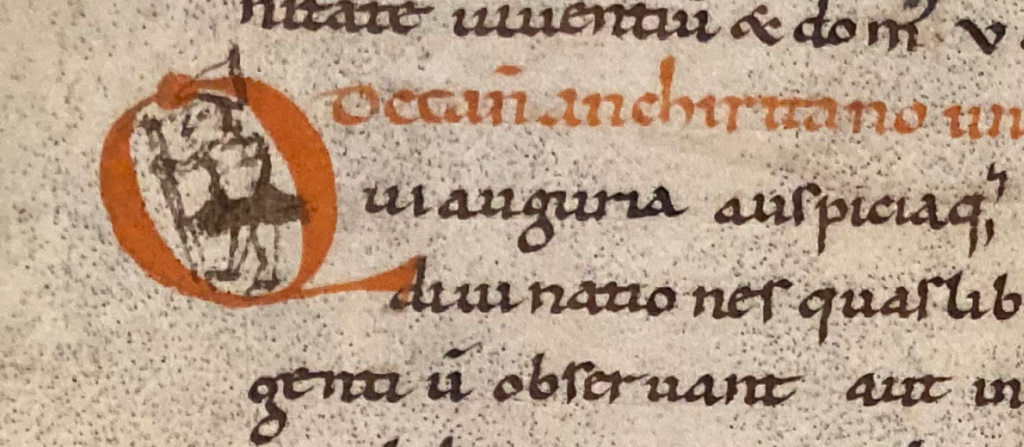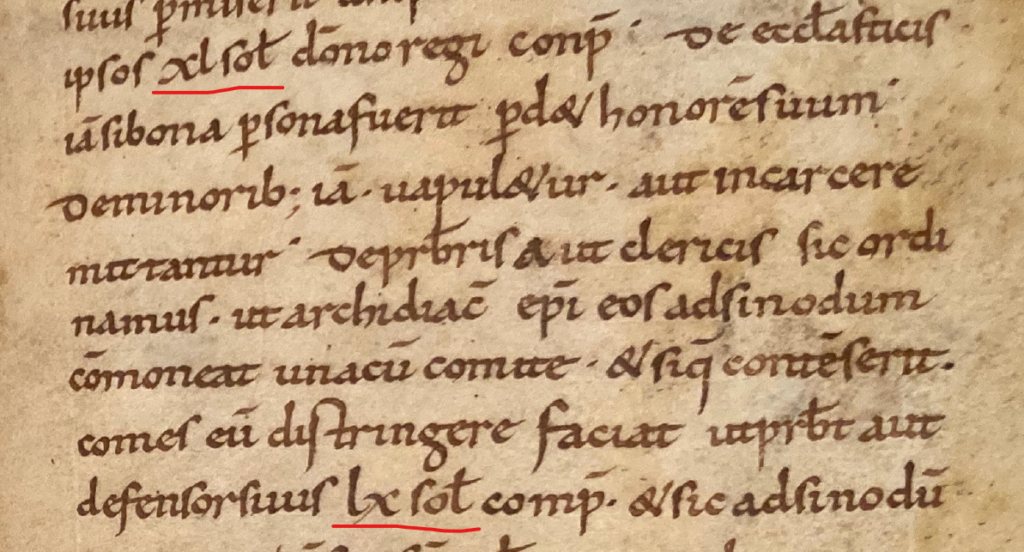It is well known that in early medieval manuscripts with canonical material, other genres of normative works often accompany ‘purely’ canonical texts. In fact, compilers of systematically arranged canonical collections not seldomly drew on royal capitularies when selecting the authoritative material for their collections. This latter phenomenon appears to be at work in the tenth- or eleventh-century manuscript now in the municipal library in Vesoul.1 Here material from the royal capitularies forms part of the canonical collection itself.
Neither the manuscript, nor the presence of excerpts from royal capitularies were unknown to previous scholars. The role of these texts within the carefully assembled material of this eleventh-century manuscript has, however, escaped detailed study.Hubert Mordek described Vesoul, Bibliothèque municipal, MS 79 (73) as a ‘typisch kirchliche Gebrauchshandschrift’,2 a typical utilitarian religious manuscript. Its mundane character is reflected in its humble material aspects. With its 88 folios measuring at most 190 x 130 mm, it is a small, handy codex that is convenient to carry around. Its low-grade parchment is of medium thickness, with numerous uneven page edges due to the use of skin from the animal’s neck, shoulders or hind. Multiple holes can be found throughout the manuscript (one hole has been repaired with stitchings—fol. 30).
Its texts were copied by several scribes, writing in a flowing Caroline minuscule, but making more than a few errors in their Latin. It is a fairly well-organised codex, with red rubrics in minuscule (rarely in capitals) separating the different works, guiding the reader through the selection of texts. This sober manuscript has only two small illustrations, which were perhaps added later: a man in a hat can be spotted in the initial Q on folio 12v (opening a statement on the performance of augury and divination), while another initial Q holds a drawing of a face (folio 23v).

The origin of the manuscript, dated to the end of the tenth century or the eleventh century, remains unclear.3 Since it made its way to the municipal library from the Abbey of Faverney, not too far from the monastery of Luxeuil, Franz Bernd Asbach assumed that the manuscript originated from the area of Luxeuil.4 The monks of Faverney, however, only came into possession of the codex in the late eighteenth century, shortly before the French revolution, possibly from an heir of magister ‘Iohannes Denisot’, whose name appears in early modern script on one of the flyleafs. This Jean Denisot may have been a member of an originally English family who moved from the Nogent area to Le Mans, which may point to an origin of the manuscript closer to Paris, but this is quite uncertain.
Importantly, it appears that the combination of texts in Vesoul 79 (73) was considered and intentional, and that the book should be studied as a whole. The codex combines authoritative statements especially relevant to secular clergy and local Christian communities with simple and brief explanations of church dogma and practice. In addition to basic penitential rules, the manuscript has a canonical collection (the Collectio 91 capitulorum) and a canonical florilegium providing guidelines detailing the behaviour of priests, prescriptions concerning fasting, Feast days, donations, as well as the clergy’s duty to teach the laity the basics of Christianity. A tract on baptism—in question-response form—and the explanations of the Creed, Mass, and Paternoster provide more practical instructions concerning the Christian cult to low-level clergy. The topics covered by the canonical collection suggest a hands-on and ‘local’ focus of the collection, something that is also reflected in the materiality of its sole surviving manuscript.
As the youngest datable text in the manuscript dates from the early ninth century—namely, a selection of excerpts from Theodulf of Orléans’s first capitulary (written sometime between 798 and 818)—, this combination of texts appears to stem from the second quarter of the ninth century. The absence of any later texts, suggests that we can consider the eleventh-century manuscript from Vesoul as a faithful copy of a ninth-century codex. It is uncertain, but not unlikely, that the sober character of the manuscript in Vesoul reflects the nature of its exemplar. We thus seem to have a tenth- or eleventh-century witness of a ninth-century small practical pastoral book.
There are excerpt from four royal capitularies within the canonical collection known as the Collectio 91 capitulorum: BK 23, BK 13, BK 15 and BK 16 (numbered according to the edition by Boretius/Krause, see the Capitularia project). The last three appear at the end of the collection, but the fragment from capitulum 19 of the so-called Duplex legationis edictum of 789 is found in the middle of the collection, as chapter 37. It calls on bishops to ensure that small nunneries find a fixed place and adopt a rule. It also asserts that abbesses should not act contrary to the rule. The rest of the capitulum, prohibiting the abbess to leave the cloister without ‘our’ command, forbidding the nuns to write or sing vulgar songs, or to perform bloodletting, is left out by the compiler of the canonical collection. The version in the Collectio 91 capitulorum also omits the finite verb of the first sentence (‘uolumus ut’), which indicates the royal authority of this decree. Instead, the chapter now seems to blend seamlessly with the surrounding chapters on nuns and abbesses (cc. 36-46), which are taken more ‘tradition’ canonical material, such as the Theodorian penitential and Gallic synodal acts.
The final chapter of the Collectio 91 capitulorum is formed by three chapters of the Pippin’s capitulary (754 x 755),5 capitula 1, 2, 3 (BK 13). The chapter discusses incest, a word not explicitly used anywhere else in the collection. The decree forbids incest with a number of listed categories of women (those consecrated to God, godmothers, family member), prescribing monetary fees, lashes or even imprisonment for violations.6 The version in Vesoul 79 (73) repeatedly—but not always—assigns a fee of 40 (XL) solidi, where the original(?) capitulary has 60 (LX).

The chapter is unique in that it strongly affirms the secular authority in matters relating to incest, stipulating that—in some case—a fine should be paid to the king and assigning a role to the comes in enforcing the rules. Ecclesiastical authority is only referenced when the offender is a cleric, in which case the bishops and the comes are supposed to cooperate in his prosecution. Because of the emphasis on secular authority, the decree would seem to be less suitable for a canonical collection, but its explicit numbering (XCI) indicates that it was clearly seen as an element of this collection of canon law. Perhaps, the royal capitulary was regarded as the most apposite normative text to treat the topic of incest for the particular audience of the Collectio 91 capitulorum.
The texts directly following the ninety-first chapter of the collection are numbered anew; seven short decrees are numerated I to VII. They therefore appear to be separate from the canonical Collectio 91 capitulorum, although the topics of the decrees dovetail rather adroitly with capitulum 91 discussed above. It seems probable that there decrees were intended to be read in the context of the Collectio 91 capitulorum (the same cluster is also found in Laon 265, fol. 162r and Paris, BnF, lat. 2796, fol. 252v).7 The statements are drawn from the Decretum Compendiense (a. 757), BK 15, cc. 1-4 and the Decretum Vermeriense (a. 756), BK 16, cc. 1, 2 (+4). They specifically address consanguinity in marriage and are particulary concerned with the question whether or not married couples related in the third or fourth grade—when discovered post factum—should be separated and whether the separated spouses are allowed to remarry to other people. The synod of Verberie saw marriages in the fourth degree as sinful, but did not advocate separation when discovered after the fact. Marriages of spouses related in the third degree, however, should be dissolved. The later synod of Compiègne (whose capitula are entered before those of Verberie in this manuscript) qualifies this approach by explicitly ordering separation of marriage between the third and fourth degree. In contrast, there were no longer any consequences for unions of those related in the fourth degree; it was no longer a case of incest.8
In fact, the first chapter of this small cluster makes it clear that marriage in the fourth degree are not separated (I = Compendiense, c. 1). This is reiterated in chapter VI (= Vermeriense, c. 1 [2]), which explains that such marriages are not allowed when the level of consanguinity is known beforehand. Where the original text of the Verberie imposes a penance on the spouses of such marriages, the version in Vesoul 79 (73) omits the requirement for penance in these cases, thereby subscribing to the tenor of the later synod at Compiègne.
Finally, capitulum VII (= Vermeriense, c. 2 (+4)) is a highly condensed version of the decree prohibiting marriage (or incest) with both mother and stepdaughter. The version in Vesoul 79 (73) reduces some of the complications of the original and explains that a wife—apparently upon discovering her husband’s sexual relations with her daughter—is allowed to opt for celibacy or to do ‘as is preached’: ‘Si quis cum filiastra sua manet nec filiam nec matrem habeat, nec aliam uxorem, nec illa filiastra uirum. Illa autem mulier, mater filiastre si uoluerit se contineri, faciat, si non potest agat quod uult tamen predicanda est.’
The capitulary fragments in Vesoul 79 (73) are thus interesting witnesses to the use of capitulary material within (the context of) collections of canon law. Their presence in this collection demonstrates the approprietness of royal normative texts for canonical works, while the rearrangement and textual variances of their versions in Vesoul point to the ability and willingness of compilers of canonical collections to edit secular statements to fit their new textual contexts.
[This is the English version of my contribution to the ‘Manuscript of the Month‘ section on the Capitularia website]9